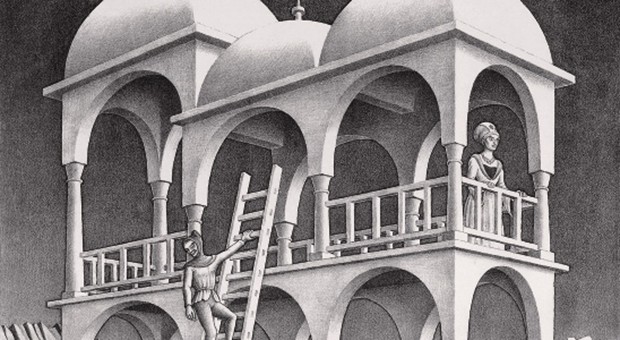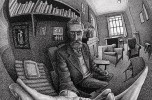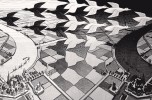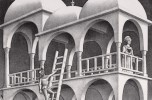La rubrica che vi guida tra le migliori mostre d’arte
Tra le numerose opportunità presenti in Lombardia in questi mesi, una mostra raffinata e imperdibile è la retrospettiva su Maurits Cornelis Escher (1898-1972), allestita a Milano, nelle sale di Palazzo Reale, fino al 22 gennaio 2017.
Reduce dal successo delle precedenti esposizioni a Roma, Treviso e Bologna (ben 580 mila visitatori), la mostra sta registrando un’elevata affluenza anche nel capoluogo meneghino; questo dato non stupisce dato che gli appuntamenti dedicati al maestro olandese sono tra le esposizioni più amate e seguite dal pubblico internazionale.
Le opere di Escher sono parte della memoria collettiva del XX secolo: le troviamo riprodotte su magliette, copertine di dischi (ricordiamo gli LP dei Pink Floyd e dei Bauhaus) e libri (come le einaudiane Cosmicomiche di Calvino).
Mondi escheriani hanno ispirato campagne pubblicitarie (Illy e Audi) e ospitato personaggi dei fumetti come Mickey Mouse e i Simpson. Il cinema ha esaltato le architetture impossibili dell’artista in film di culto: il fantastico Labyrinth (1986) con David Bowie, il visionario Inception (2010) di Cristopher Nolan e persino la saga di Harry Potter, con le celebri rampe fatate del castello di Hogwarts.
Se oggi è lecito parlare di “escher-mania”, bisogna anche dire che all’inizio della sua carriera e per molti anni, il grafico olandese non ottenne grande successo né riconoscimento artistico per le sue opere. Inizialmente conquistò le menti di matematici, cristallografi e scienziati, rapiti da opere che facevano confrontare lo spettatore con i paradossi della logica e le regole geometriche.
L’artista rappresentava con la fantasia i difficili concetti che appartengono alla matematica pura, creando opere enigmatiche il cui senso sfuggiva agli occhi dei più. Fu negli anni Sessanta che le creazioni del geniale maestro ottennero un più ampio consenso, quando la controcultura hippy lo esaltò come pioniere dell’arte psichedelica.
Escher, dal canto suo, rifiutava qualsiasi etichetta ed era irritato da questo interesse; è celebre l’aneddoto che ricorda di un suo ammiratore di nome Mick Jagger che fece l’errore di scrivergli una lettera chiamandolo per nome: la risposta di Escher all’agente del cantante fu lapidaria: “La prego di informare il signor Jagger che per lui non mi chiamo Maurits ma M.C. Escher”.
E non cedette neppure ai corteggiamenti di Stanley Kubrick che lo aveva contattato per aiutarlo a trasformare quello che divenne “2001: odissea nello spazio” in un film a quattro dimensioni.
Tra le duecento opere in mostra a Milano spiccano le celeberrime Mano con sfera riflettente (1935), nella quale l’artista esplora il tema della deformazione dell’immagine attraverso superfici specchianti, il blackout architettonico Relatività (o Casa di Scale, 1953), e Belvedere (1958), edificio impossibile popolato di figure che evocano l’universo di Hieronymus Bosh.
Una sezione dell’esposizione prende il nome da Metamorfosi (1937), uno dei capolavori assoluti della produzione di Escher: in quest’opera l’artista mette in azione una trasformazione di soggetti attraverso passaggi graduali basati su assonanze logiche e formali.
Si tratta del suo più noto esempio di tassellazione del piano, tecnica già usata nelle decorazioni moresche dell’Alhambra di Granada e divenuta uno dei motivi ricorrenti e distintivi dell’opera dell’artista.
Se i Mori si limitavano ad incastri composti di forme e colori, Escher esplorò la possibilità di creare puzzle utilizzando figure animate come pesci e uccelli.
Le opere di questo artista sui generis non accusano i segni del tempo e continuano ad esercitare sugli spettatori un’attrazione magnetica.
La rappresentazione grafica di cortocircuiti logici rende esplicito ciò che Aristotele ripete alla fine della Poetica: “una convincente impossibilità è preferibile ad una non convincente possibilità”. Escher, che amava dire che “lo stupore è il sale della terra”, gioca con la realtà come un prestigiatore e spiazza proponendo prospettive impossibili ma rappresentabili.
Le sue opere sono paradossi percettivi che dimostrano come l’illusione faccia parte della realtà. Sta a chi osserva scoprire l’inganno e sorprendersi del fatto che, a un primo sguardo, ci aveva creduto.
Per maggiori informazioni: www.mostraescher.it
Livia Salvi
Dida foto: Maurits Cornelis Escher, Mano con sfera riflettente (1935), Litografia, 31,1x21,3 cm. Fondazione M.C. Escher. All M.C. Escher works © 2016 The M.C. Escher Company The Netherlands. All rights reserved. www.mcescher.com
TRADUZIONE IN INGLESE A OPERA DI VICEVERSAGROUP
Escher: what is the reality of an illusion? The column that will guide you through the best art exhibitions
 Among the numerous opportunities in Lombardy in these months, a refined and unmissable exhibition is surely the retrospective on Maurits Cornelis Escher (1898-1972), organised in Milan, in the halls of Palazzo Reale, until 22 January 2017.
Among the numerous opportunities in Lombardy in these months, a refined and unmissable exhibition is surely the retrospective on Maurits Cornelis Escher (1898-1972), organised in Milan, in the halls of Palazzo Reale, until 22 January 2017.If today it is acceptable to talk about “Escher-mania”, we must also say that at the beginning of his career and for many years, the Dutch graphic artist did not achieve great success or artistic recognition for his works. Initially he conquered the minds of mathematicians, crystallographers, and scientists, fascinated by works that made the spectator confront himself with paradoxes of logic and geometric rules.
The artist represented with fantasy the difficult concepts belonging to pure mathematics, creating enigmatic works whose meaning was not understood by many. It was in the Sixties that the creations of the brilliant master obtained great appreciation, when the hippy counterculture exalted him as a pioneer of psychedelic art.
Escher, on the other hand, refused any label and was irritated by this interest; famous is the anecdote that he remembers about one of his fans called Mick Jagger that made the mistake of calling him by name in a letter he wrote him: Escher’s reply to the singer’s assistant was concise: “Please tell Mr. Jagger that I am not Maurits to him, but M.C. Escher”.
He also turned down Stanley Kubrick’s request for help to transform, what became “2001: A Space Odyssey” into a fourth-dimensional film.
Among the two hundred works exhibited in Milan the very famous Hand with Reflecting Sphere (1935), in which the artist explores the theme of image deformation through mirroring surface, the architectonic blackout Relativity (or House of Stairs, 1953), and Belvedere (1958), impossible building filled with figures that evoke the Hieronymus Bosh universe stand out.
A section of the exhibition is named after Metamorphosis (1937), one of Escher’s absolute masterpieces: in this work the artist shows a gradual progression of transformation based on logic and formal assonances. It is his most famous example of tessellation of the surface, a technique already used in the Moresque decorations of the Alhambra in Granada that became one of the recurring and distinctive patterns of the artist’s work.
If the Moors only used an orderly interlocking of forms and colours, Escher explored the possibility to create puzzles using animated figures such as fish and birds.
The works of this unique artist do not show the signs of time and continue to magnetically attract spectators.
The graphic representation of logical short-circuits makes explicit what Aristotle repeats at the end of Poetics: “a convincing impossibility is preferable to an unconvincing possibility”.
Escher, who loved to say that “wonder is the salt of the earth”, played with reality like an illusionist and overwhelmed proposing impossible, but representable, perspectives. His works are perceptive paradoxes that demonstrate how illusion is part of reality. The person that observes must discover where the deception is and mock his own credulity.
Mostre in Lombardia e non solo
> David Bowie is - Bologna - Museo d’Arte Moderna di Bologna (MAMbo). Fino al 13 novembre 2016.
> Nella mente di Vincenzo Scamozzi. Un intellettuale architetto al tramonto del Rinascimento - Vicenza - Palladium Museum. Fino al 20 novembre 2016.
> Sol LeWitt - Milano - Studio Gian Galezzo Visconti. Fino al 25 novembre 2016.
> W. Eugene Smith. Lasciamo che la verità sia il pregiudizio - Milano - Centro Culturale di Milano. Fino al 4 dicembre.
> Wildlife Photograher of the Year - Milano - Fondazione Luciana Matalon. Fino al 4 dicembre 2016.
> Guttuso. La forza delle cose - Pavia - Scuderie del Castello Visconteo. Fino al 18 dicembre 2016.
> Longaretti 100. Opere pubbliche - Bergamo - varie sedi (mappa e informazioni sul sito www.gamec.it). Fino al 31 dicembre 2016.
> Michelangelo Pistoletto. Immagini in più, Oggetti in meno, un Paradiso ancora/Fabio Mauri. Arte per legittima difesa- Bergamo - GAMeC. Dal 7 ottobre 2016 all’8 gennaio 2017.
> Albrecht Dürer. Incisioni e influssi - Mantova - Palazzo Ducale. Fino all’8 gennaio 2017.
> La guerra è finita. Nasce la Repubblica. Milano 1945-1946 - Cinisello Balsamo (Mi) - Museo di Fotografia Contemporanea. Fino al 15 gennaio 2017.
> Escher - Milano - Palazzo Reale. Fino al 22 gennaio 2017.
> Hokusai, Hiroshige, Utamaro. Luoghi e volti del Giappone che ha conquistato l’Occidente - Milano Palazzo Reale. Fino al 29 gennaio 2017.
> Homo Sapiens. Le nuove storie dell’evoluzione umana - Milano - MUDEC. Fino al 26 febbraio 2017.
> Dada 1916. La nascita dell’antiarte - Brescia - Museo di Santa Giulia. Fino al 26 febbraio 2017.
















